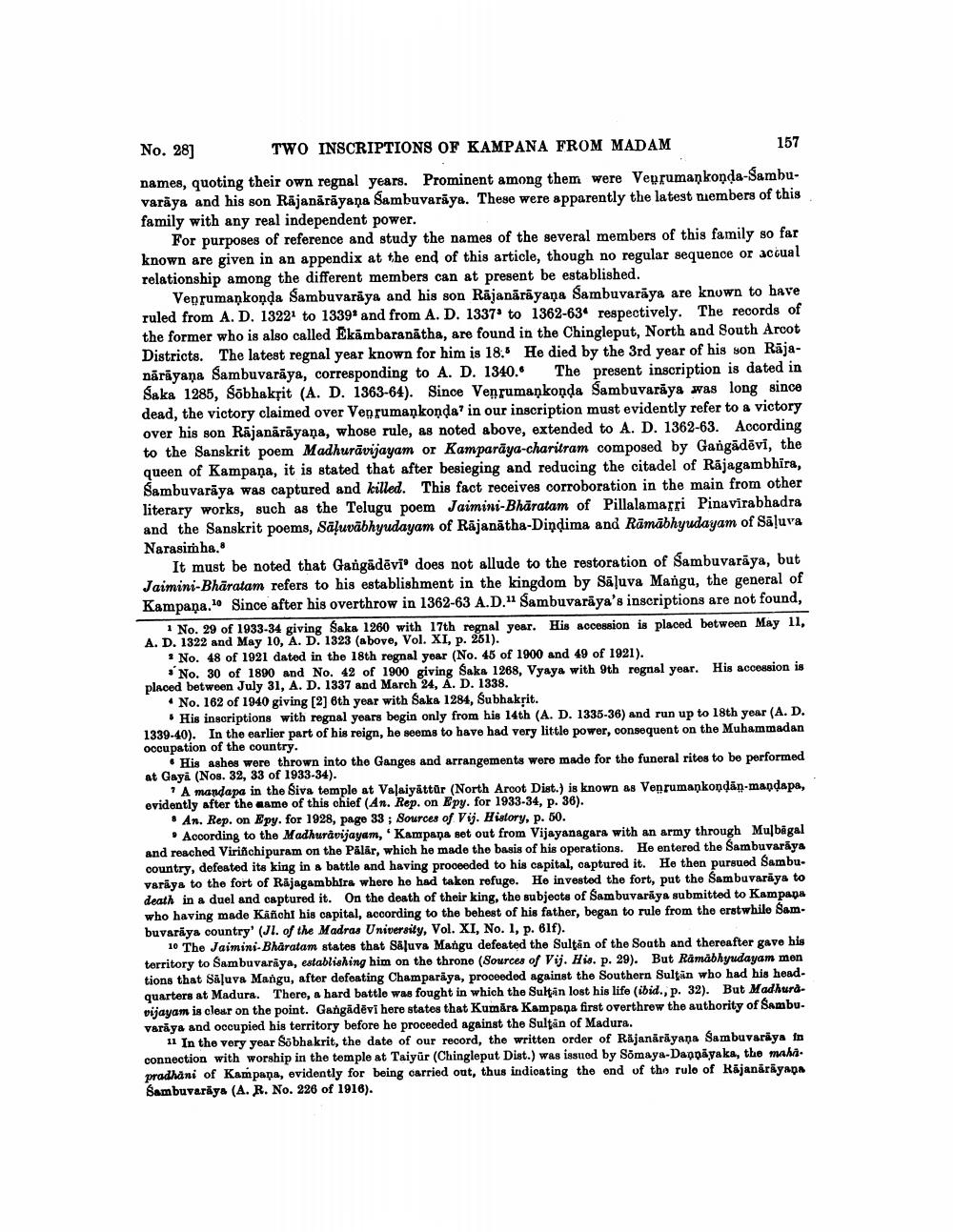________________
No. 28] TWO INSCRIPTIONS OF KAMPANA FROM MADAM
157 names, quoting their own regnal years. Prominent among them were Veprumaņkonda-Sambuvarāya and his son Rājanārāyana Sambuvarāya. These were apparently the latest nembers of this family with any real independent power.
For purposes of reference and study the names of the several members of this family so far known are given in an appendix at the end of this article, though no regular sequence or accual relationship among the different members can at present be established.
Veprumaņkonda Sambuvarāya and his son Rājanārāyaṇa Sambuvarāya are known to have ruled from A. D. 13221 to 1339and from A. D. 1337 to 1362-63° respectively. The records of the former who is also called Ekambaranátha, are found in the Chingleput, North and South Arcot Districts. The latest regnal year known for him is 18.5 He died by the 3rd year of his son Räjanāriyana Sambuvarāya, corresponding to A. D. 1340. The present inscription is dated in Saka 1285, Sõbhakrit (A. D. 1363-64). Since Venrumaņkonda Sambuvarāya was long since dead, the victory claimed over Veprumaņkonda' in our inscription must evidently refer to a victory over his son Rājanārāyana, whose rule, as noted above, extended to A. D. 1362-63. According to the Sanskrit poem Madhurāvijayam or Kamparāya-charitram composed by Gangādēvi, the queen of Kampana, it is stated that after besieging and reducing the citadel of Rājagambhira, Sambuvarāya was captured and killed. This fact receives corroboration in the main from other literary works, such as the Telugu poem Jaimini-Bharatam of Pillalamarri Pinavirabhadra and the Sanskrit poems, Sāļuvābhyudayam of Rājanātha-Dindima and Rāmābhyudayam of Sāļuva Narasimha.
It must be noted that Gangādēvio does not allude to the restoration of Sambuvarāya, but Jaimini-Bharatam refers to his establishment in the kingdom by Säluva Mangu, the general of Kampaņa.10 Since after his overthrow in 1362-63 A.D." Sambuvaraya's inscriptions are not found,
No. 29 of 1933-34 giving Saka 1260 with 17th regnal year. His AOCOSSION is placed between May 11, A. D. 1322 and May 10, A. D. 1323 (above, Vol. XI, p. 251).
* No. 48 of 1921 dated in the 18th regnal year (No. 45 of 1900 and 49 of 1921).
* No. 30 of 1890 and No. 42 of 1900 giving Saka 1268, Vyaya with 9th regnal year. His accession is placed between July 31, A. D. 1337 and March 24, A. D. 1338.
No. 162 of 1940 giving [2] 6th year with Saka 1284, Subhaksit.
His inscriptions with regnal years begin only from his 14th (A. D. 1335-36) and run up to 18th year (A. D. 1339-40). In the earlier part of his reign, he seems to have had very little power, consequent on the Muhammadan occupation of the country.
His ashes were thrown into the Ganges and arrangements were made for the funeral rites to be performed at Gaya (Nos. 32, 33 of 1933-34).
A mandapa in the Siva templo at Valaiyáttur (North Aroot Dist.) is known as Venrumankondän-mapdapa, evidently after the same of this chief (An. Rep. on Epy. for 1933-34, p. 36).
* An. Rep. on Epy. for 1928, page 33 ; Sources of Vij. History, p. 50.
According to the Madhuravijayam, Kampana set out from Vijayanagara with an army through Mulbāgal and reached Virinchipuram on the Palar, which he made the basis of his operations. He entered the Sambuvaraya country, defeated its king in a battle and having proceeded to his capital, captured it. He then pursued Sambu. varaya to the fort of Rajagambhira where he had taken refuge. He invested the fort, put the Sambuvaraya to death in a duel and captured it. On the death of their king, the subjects of Sambuvaraya submitted to Kampapa who having made Kafichi his capital, according to the behest of his father, began to rule from the erstwhile Sambuvarāya country' (Jl. of the Madras University, Vol. XI, No. 1, p. 61f).
10 The Jaimini-Bharatam states that Saluva Mangu defeated the Sultan of the South and thereafter gave his territory to Sambuvariya, establishing him on the throne (Sources of Vij. His. p. 29). But Ramabhyudayam men tions that Säļuva Mangu, after dofoating Champariya, proceeded against the Southern Sultan who had his head. quarters at Madura. There, a hard battle was fought in which the Sultan lost his life (ibid., p. 32). But Madhura. vijayam is clear on the point. Gangadevi here states that Kumāra Kampana first overthrow the authority of Sambuvariya and occupied his territory before he proceeded against the Sultan of Madura.
11 In the very year Sobhakrit, the date of our record, the written order of Räjanārāyana Sambuvaraya in connection with worship in the temple at Taiyur (Chingleput Dist.) was issued by Somaya-Daopayaka, the maki. pradhani of Kampaņa, evidently for being carried out, thus indicating the end of the rulo of Kājanarayana Sambuvariya (A. R. No. 226 of 1916).




